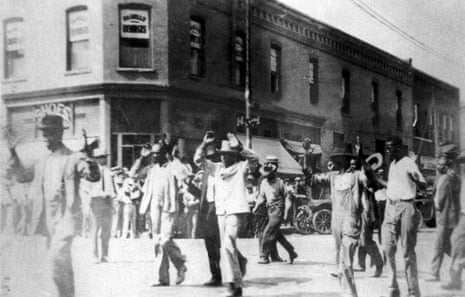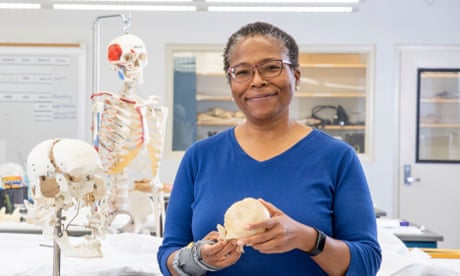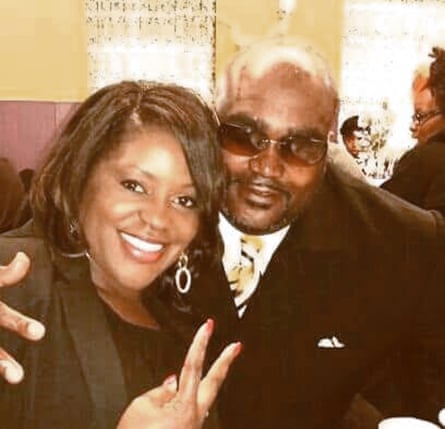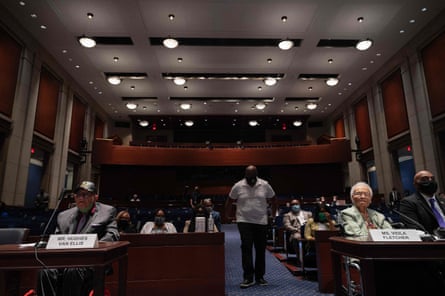On the 102nd anniversary of the killings, efforts for justice in Greenwood are buried under hollow symbolism

After white rioters torched Black businesses in the Greenwood district, authorities detained thousands of Black people.
Photograph: Science History Images/Alamy
Victor Luckerson
THE GUARDIAN
Wed 31 May 2023
This year, on the 102nd anniversary of the Tulsa race massacre, television crews won’t descend upon Greenwood, the neighborhood where as many as 300 Black people were murdered by a white mob in 1921. Thousands of protesters won’t march through the streets chanting “justice for Greenwood”, as they did following the murder of George Floyd in May 2020. Joe Biden won’t be on hand to declare Greenwood a symbol of the “American spirit”, as he did on the centennial of the race massacre in 2021.
Despite the pop culture awareness delivered by HBO’s Watchmen and Lovecraft Country, Greenwood risks going it alone once again. All too often, that’s been the normal state of play in the neighborhood known across the United States as “Black Wall Street”.

This year, on the 102nd anniversary of the Tulsa race massacre, television crews won’t descend upon Greenwood, the neighborhood where as many as 300 Black people were murdered by a white mob in 1921. Thousands of protesters won’t march through the streets chanting “justice for Greenwood”, as they did following the murder of George Floyd in May 2020. Joe Biden won’t be on hand to declare Greenwood a symbol of the “American spirit”, as he did on the centennial of the race massacre in 2021.
Despite the pop culture awareness delivered by HBO’s Watchmen and Lovecraft Country, Greenwood risks going it alone once again. All too often, that’s been the normal state of play in the neighborhood known across the United States as “Black Wall Street”.

A man raises a fist after a soil dedication ceremony on the centennial of the massacre. Photograph: Andrew Caballero-Reynolds/AFP/Getty Images
When I first arrived in Tulsa in 2018, on the 97th anniversary of the race massacre, Greenwood felt diminished. A lively Black district once filled with regal homes, raucous nightclubs and stately churches had been reduced to a block and half of humble storefronts and a community center in need of refurbishment. What’s worse, much of the land previously occupied by Black people had been replaced by white-controlled enterprises: high-rise apartments, a large college campus for Oklahoma State University, and even a sports stadium. On my first night in Greenwood, more people on the block were trying to catch the opening inning of a minor league baseball game than acknowledging the lives of people who had been slain on the land where that stadium now sits.
Greenwood is full of these kinds of chilling contradictions. Sidewalk plaques commemorating businesses burned down during the massacre now serve as welcome mats for glittering new office buildings. The highway that bisected the neighborhood in 1967, destroying dozens of homes and businesses, has been “beautified” with a mural, attracting Instagram likes rather than material gains for Greenwood’s progeny. The neighborhood’s historical fame has become a kind of albatross slung over Black Tulsans’ necks, as efforts at building concrete pathways toward justice are buried under hollow symbolism.

‘I work with the dead. But this can help the living’: the anthropologist investigating the Tulsa race massacre
It’s easy for visitors – and visiting journalists – to become distracted by the symbols, beautiful as some of them are. But after my first trip to the neighborhood, I realized the only way to really understand Greenwood was to become part of it. So I moved to Tulsa a few days after my 30th birthday and rented a house a half-mile walk from the neighborhood. I began excavating Greenwood’s past, analyzing land transactions and lawsuits filed in the aftermath of the race massacre and conducting oral history interviews with people whose families were devastated by the attack. I spoke to families who have called the place home for generations. I also sought to chronicle Greenwood’s present, covering protests, court hearings and debates on the floor of the Oklahoma state legislature, all mechanisms for restoring justice to a community that’s been deprived of it for so long.
![]()
01:09'Ain't Gonna Let Nobody Turn Me Around': reverend sings with Tulsa race massacre survivors – video
Three years after the murder of George Floyd, police violence remains one of the most urgent concerns for Black Tulsans. Tiffany Crutcher, a descendant of race massacre survivors, has been an ardent police reform activist ever since her twin brother, Terence, was killed while unarmed by a Tulsa police officer in 2016. Following Terence’s death, she moved back home to Tulsa to pursue activism, spending years trying to needle the Tulsa city council and the city’s Republican mayor, GT Bynum, into taking police oversight seriously.
The summer of 2020 seemed to offer a breakthrough; as the nation reeled from Floyd’s murder at the hands of police in Minneapolis, local protests in Tulsa brought thousands into the streets, blocking highway traffic and forcing a negotiation with the mayor. In those heady, turbulent days, Bynum promised to take on the police union, notorious for eschewing oversight and citizen intervention at all costs. But the season of change was short-lived in Tulsa, as elsewhere; Bynum ultimately walked back his plan to institute an independent monitor to oversee the police, instead supporting a “liaison” who would lack any disciplinary power.
When I first arrived in Tulsa in 2018, on the 97th anniversary of the race massacre, Greenwood felt diminished. A lively Black district once filled with regal homes, raucous nightclubs and stately churches had been reduced to a block and half of humble storefronts and a community center in need of refurbishment. What’s worse, much of the land previously occupied by Black people had been replaced by white-controlled enterprises: high-rise apartments, a large college campus for Oklahoma State University, and even a sports stadium. On my first night in Greenwood, more people on the block were trying to catch the opening inning of a minor league baseball game than acknowledging the lives of people who had been slain on the land where that stadium now sits.
Greenwood is full of these kinds of chilling contradictions. Sidewalk plaques commemorating businesses burned down during the massacre now serve as welcome mats for glittering new office buildings. The highway that bisected the neighborhood in 1967, destroying dozens of homes and businesses, has been “beautified” with a mural, attracting Instagram likes rather than material gains for Greenwood’s progeny. The neighborhood’s historical fame has become a kind of albatross slung over Black Tulsans’ necks, as efforts at building concrete pathways toward justice are buried under hollow symbolism.

‘I work with the dead. But this can help the living’: the anthropologist investigating the Tulsa race massacre
It’s easy for visitors – and visiting journalists – to become distracted by the symbols, beautiful as some of them are. But after my first trip to the neighborhood, I realized the only way to really understand Greenwood was to become part of it. So I moved to Tulsa a few days after my 30th birthday and rented a house a half-mile walk from the neighborhood. I began excavating Greenwood’s past, analyzing land transactions and lawsuits filed in the aftermath of the race massacre and conducting oral history interviews with people whose families were devastated by the attack. I spoke to families who have called the place home for generations. I also sought to chronicle Greenwood’s present, covering protests, court hearings and debates on the floor of the Oklahoma state legislature, all mechanisms for restoring justice to a community that’s been deprived of it for so long.
01:09'Ain't Gonna Let Nobody Turn Me Around': reverend sings with Tulsa race massacre survivors – video
Three years after the murder of George Floyd, police violence remains one of the most urgent concerns for Black Tulsans. Tiffany Crutcher, a descendant of race massacre survivors, has been an ardent police reform activist ever since her twin brother, Terence, was killed while unarmed by a Tulsa police officer in 2016. Following Terence’s death, she moved back home to Tulsa to pursue activism, spending years trying to needle the Tulsa city council and the city’s Republican mayor, GT Bynum, into taking police oversight seriously.
The summer of 2020 seemed to offer a breakthrough; as the nation reeled from Floyd’s murder at the hands of police in Minneapolis, local protests in Tulsa brought thousands into the streets, blocking highway traffic and forcing a negotiation with the mayor. In those heady, turbulent days, Bynum promised to take on the police union, notorious for eschewing oversight and citizen intervention at all costs. But the season of change was short-lived in Tulsa, as elsewhere; Bynum ultimately walked back his plan to institute an independent monitor to oversee the police, instead supporting a “liaison” who would lack any disciplinary power.

Terence Crutcher, right, with his twin sister, Tiffany. Photograph: AP
Crutcher has watched this retrenchment with concern, but she remains undeterred. She now heads the Terence Crutcher Foundation, a local non-profit she launched a year after her brother was killed. Her work has shifted from trying to convince city leaders of the value of her agenda to taking it to the people themselves. “It looks like knocking on doors and listening to neighbors to understand what’s important to them,” she says of her advocacy. “I think it looks like bringing them along in this fight to advance policy, and giving them ownership for their own communities.” The foundation recently purchased a 65,000-square-foot shopping center just north of Greenwood, which it hopes to fill with small businesses and non-profits that can help transform Black Tulsa’s economic fortunes.
Another descendant of massacre survivors, Regina Goodwin, is determined to restore Greenwood’s physical landscape by removing the I-244 overpass from the neighborhood. As a child, Goodwin saw her family’s Greenwood Avenue office building destroyed to make room for the highway; a few years later, her home was bulldozed during urban renewal programs. Now Goodwin, a state legislator representing the Greenwood district, is calling for freeing up about 30 acres of land in and around the neighborhood for commercial and residential development benefiting the community’s historic residents.
Crutcher has watched this retrenchment with concern, but she remains undeterred. She now heads the Terence Crutcher Foundation, a local non-profit she launched a year after her brother was killed. Her work has shifted from trying to convince city leaders of the value of her agenda to taking it to the people themselves. “It looks like knocking on doors and listening to neighbors to understand what’s important to them,” she says of her advocacy. “I think it looks like bringing them along in this fight to advance policy, and giving them ownership for their own communities.” The foundation recently purchased a 65,000-square-foot shopping center just north of Greenwood, which it hopes to fill with small businesses and non-profits that can help transform Black Tulsa’s economic fortunes.
Another descendant of massacre survivors, Regina Goodwin, is determined to restore Greenwood’s physical landscape by removing the I-244 overpass from the neighborhood. As a child, Goodwin saw her family’s Greenwood Avenue office building destroyed to make room for the highway; a few years later, her home was bulldozed during urban renewal programs. Now Goodwin, a state legislator representing the Greenwood district, is calling for freeing up about 30 acres of land in and around the neighborhood for commercial and residential development benefiting the community’s historic residents.

Joe Biden silently prays during a moment of silence in Tulsa in 2021.
Photograph: Brandon Bell/Getty Images
One idea being weighed is converting the property into a land trust owned by the community as a whole, so that previous patterns of gentrification aren’t repeated. “Everybody thinks it’s crazy,” Goodwin says. “This big piece of concrete, that’s all folks have known all their lives. But if you constructed it, you can deconstruct it.” Her plan gained a major boost in February, when the US Department of Transportation selected Greenwood as one of 49 communities that will receive federal grant funding to conduct a feasibility study on potentially removing the highway. On a personal level, Goodwin knows the pain Greenwood has endured, but she’s also become adept at using some of the tools that engineered Greenwood’s destruction to power its restoration.
In addition to the massacre descendants, three people remain who lived through the horror themselves, and they too seek justice. Since 2020, three survivors of the Tulsa race massacre have been seeking restitution through a lawsuit against the city of Tulsa, other government agencies, and the Tulsa Chamber of Commerce (massacre descendants were dismissed from the case last summer). The eldest of the survivors, Viola Ford Fletcher, marked her 109th birthday this May in a Tulsa county courtroom, where her attorneys were fending off a motion filed by the city to dismiss the case.

One idea being weighed is converting the property into a land trust owned by the community as a whole, so that previous patterns of gentrification aren’t repeated. “Everybody thinks it’s crazy,” Goodwin says. “This big piece of concrete, that’s all folks have known all their lives. But if you constructed it, you can deconstruct it.” Her plan gained a major boost in February, when the US Department of Transportation selected Greenwood as one of 49 communities that will receive federal grant funding to conduct a feasibility study on potentially removing the highway. On a personal level, Goodwin knows the pain Greenwood has endured, but she’s also become adept at using some of the tools that engineered Greenwood’s destruction to power its restoration.
In addition to the massacre descendants, three people remain who lived through the horror themselves, and they too seek justice. Since 2020, three survivors of the Tulsa race massacre have been seeking restitution through a lawsuit against the city of Tulsa, other government agencies, and the Tulsa Chamber of Commerce (massacre descendants were dismissed from the case last summer). The eldest of the survivors, Viola Ford Fletcher, marked her 109th birthday this May in a Tulsa county courtroom, where her attorneys were fending off a motion filed by the city to dismiss the case.

Hughes Van Ellis, left, a Tulsa race massacre survivor, and Viola Ford Fletcher, the eldest living survivor, testify on Capitol Hill in May 2021.
Photograph: Jim Watson/AFP/Getty Images
During the hearing, the lead attorney, Damario Solomon-Simmons, listed iconic Greenwood landmarks that had been destroyed during the race massacre, including the Stratford Hotel and the Dreamland Theater, and argued that the survivors had suffered through the destruction of many vital community institutions. “We just want the opportunity – they just want the opportunity – to have their day in court,” Solomon-Simmons said. “There were over 10,000 people who suffered during the massacre. They’re the three that’s left.” A decision on whether to dismiss the case or let it proceed to
During the hearing, the lead attorney, Damario Solomon-Simmons, listed iconic Greenwood landmarks that had been destroyed during the race massacre, including the Stratford Hotel and the Dreamland Theater, and argued that the survivors had suffered through the destruction of many vital community institutions. “We just want the opportunity – they just want the opportunity – to have their day in court,” Solomon-Simmons said. “There were over 10,000 people who suffered during the massacre. They’re the three that’s left.” A decision on whether to dismiss the case or let it proceed to
No comments:
Post a Comment